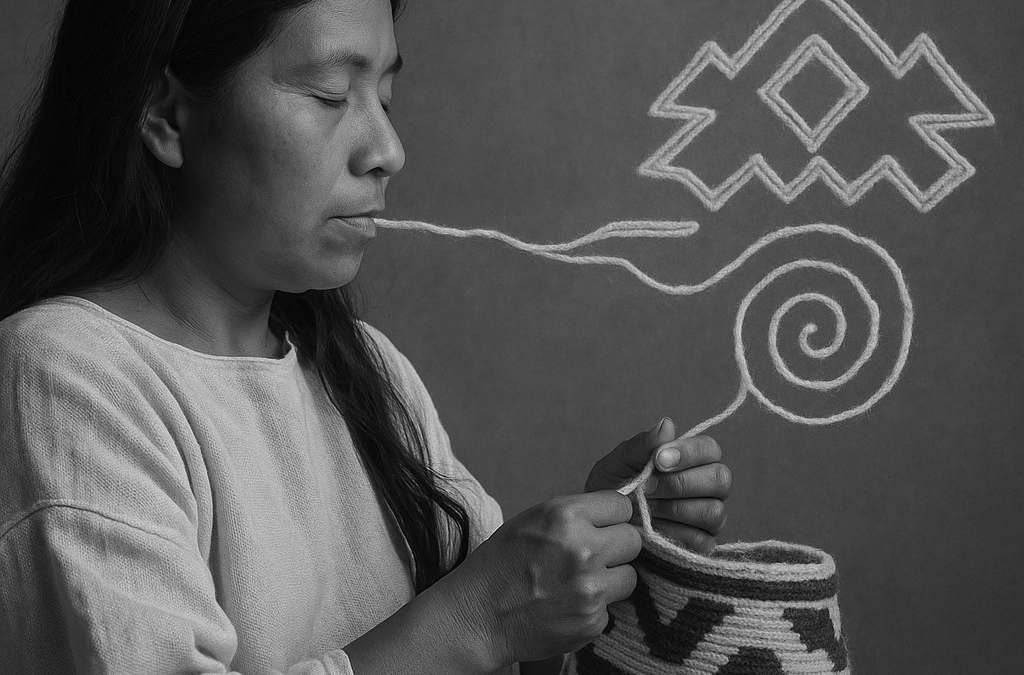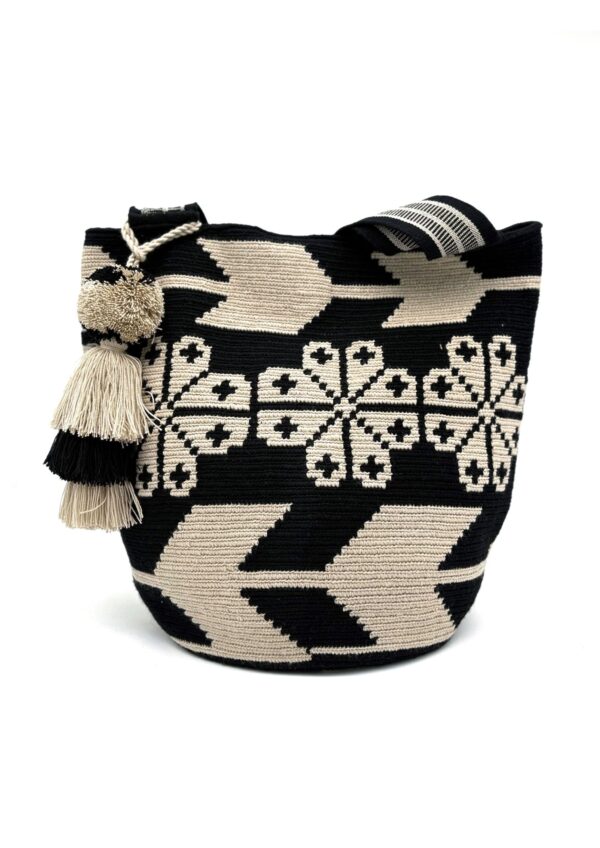Inside the Spiritual Language of Indigenous Mochila Patterns
The spiral, the triangle, the jagged line — they are not decorations. They are not trends. They are not designed the way most people understand design. In the hands of the Indigenous women who weave them, these mochila patterns carry memory, instruction, prayer. The symbols speak — to the earth, to the spirits, to those who came before and those still to come.
1. The Hands Remember
In a Kogui village high in the Sierra Nevada de Santa Marta, a woman sits cross-legged in the dirt, weaving without a sketch, without a plan. There is no paper, no template, no sample to follow. Her fingers move with practiced rhythm, guiding fique fiber thread in and out, up and around. Her gaze is steady, but far away.
She is not designing a pattern. She is remembering it.
“We don’t need to draw it,” said one weaver. “The thread already knows.”
For Indigenous women across Colombia — the Kogui, Arhuaco, Wayuu, Wiwa, and others — the mochila is more than a bag. It is a continuation. A thread that runs from one generation to the next, never cut, always carried. Every stitch holds something: a lesson from an elder, a story of a mountain, the grief of losing a child, the silence of dawn after rain.
Some patterns come in dreams. Others are taught over a fire. None of them are meaningless.
2. A Vocabulary Without Words
Each community holds its own symbolic language. Among the Arhuaco, the spiral often represents the origin of life. The four-pointed cross can symbolize the four sacred mountains. The vertical lines might mark the path between the material and spiritual worlds.
Among the Wayuu, geometric symbols are tied to clan identity — passed down from mother to daughter like a surname.
Some women weave patterns for protection. Others for fertility. Others still as a form of healing, marking a loss with lines too quiet to speak aloud.
“This one is for my son,” said one Arhuaca woman, tracing the edge of a thick, dark border. “He was born during the dry season. I prayed for water. I put the prayer here.”
To a buyer, it might look like an aesthetic choice — a color pairing or a design motif. But to the woman who wove it, it may hold years of memory, mourning, or hope. The pattern might be a map. A hymn. A warning. A piece of advice meant only for her granddaughter.
3. When the Symbols Get Misunderstood
In marketplaces and online shops, the language of the mochila is often silenced. Patterns become interchangeable. Descriptions get reduced to “geometric.” There are requests to “add this color” or “match that shape.” But the real patterns don’t work like that. They aren’t customized. They’re born from life, not from trend boards.
This misunderstanding — of the bag as product rather than expression — risks flattening centuries of tradition into a commodity. It assumes the mochila was made for us, when in reality, it was never meant to be explained to outsiders at all.
That’s why we don’t rename patterns. We don’t ask for logos. We don’t design for the market. We let the women weave what they know, what they feel, what they carry.
Because it’s not our language. It’s theirs.
4. When Language Begins to Disappear
Many Indigenous languages in Colombia are endangered. Young people leave the villages. Spanish becomes dominant. Formal schooling replaces oral memory. And yet, even when spoken language begins to fade, the patterns endure.
The mochila holds what the voice can no longer say.
“My grandmother didn’t go to school. But her bag told everything,” one weaver told us.
In this way, the mochila is more than preservation — it’s resilience. It protects the sacred knowledge of land, family, and cosmos in the quietest way possible. It carries it forward.
5. We Don’t Translate the Ending
Sometimes we’re asked what a certain symbol means. And if the woman who made the bag is willing, we’ll share. But many times, the answer isn’t ours to give. Some meanings aren’t meant to be translated. Some stories are too sacred, too personal, or too vast to fit into a caption.
That’s not a barrier. That’s a boundary.
So we don’t always explain the pattern. We don’t always subtitle the story. We let it speak in the language it was meant for.
Because not all threads are meant to be pulled.
Some are meant to be held — with care
We share this story as Woven Wildly — a living collaboration with Indigenous communities of the Sierra Nevada de Santa Marta. We don’t just sell mochilas. We carry culture.
Thank you for reading, for caring, and for helping preserve what matters.

This is what it’s really about — not just what we carry, but who we carry it for.
Every mochila sold helps keep these communities strong, self-sustaining, and seen.




